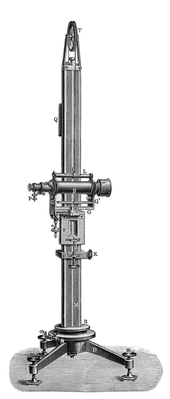Cathetometer
A cathetometer is an optical device used to observe and measure small changes in the position of an object. It consists of a telescope , which can be adjusted in height and width using spindle screws . The entire structure is expediently on a tripod to prevent the cathetometer from tilting. A level can be used to check whether the device is exactly horizontal . A change in position can be read off from a tenth of a millimeter scale .
principle
The cathetometer carries out a direct measurement by determining the position of a point in two spatial directions. The telescope is used to observe the point, the spindle drives are used to track the telescope. If the tracking takes place along an axis parallel to the movement of the object, the change in position can be read directly from the tracking scales. A shift towards or away from the cathetometer cannot be measured.
Measurement
In order to measure a change in length with a cathetometer, it is set up at a suitable distance (often less than one meter) in front of the object to be measured so that the object can be seen clearly through the lens . With a crosshair you can find a specific point, e.g. B. aim at the meniscus of a liquid column as a reference point. Aiming here means that the crosshair and reference point are exactly aligned at an angle of 0 ° to the horizontal in the lens.
Before you carry out and measure the change in length, take the values for height or width as reference values. After the change, you aim for the reference point again by moving the telescope up or down with the spindle screws, note the height and width of the point and obtain the absolute change in length from the difference to the reference values.

